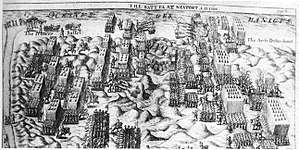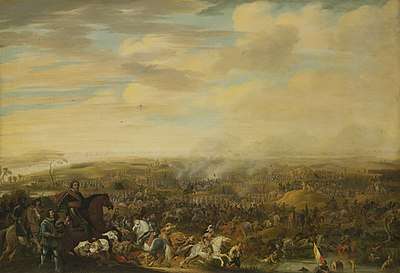Battle of Nieuwpoort
The Battle of Nieuwpoort,[1] was a battle during the Eighty Years War between a Spanish army under Albert of Austria and an army of the Dutch Republic and its protestant allies of England and the Kingdom of Scotland, under the commands of Maurice of Nassau and Francis Vere. It took place on 2 July 1600 near the city Nieuwpoort in what is now Belgium.
Campaign
The States General under Johan van Oldenbarneveldt had ordered Maurice - in spite of his very strong opposition - to take the army, march south along the coast and take the pirate nest of Dunkirk; the divergence of opinion on this matter between Maurice and Van Oldenbarneveldt, was an early sign that the two de facto leaders of the Dutch Republic were beginning to drift apart; this rivalry would eventually lead to the arrest and execution of Van Oldenbarneveldt in 1619.
It was thought that the vicious and protracted mutiny of a great part of the Spanish troops, would make it impossible for the Archduke to collect an army for the relief of the city.
For this operation, by 21 June Maurice had collected an army of 12 infantry regiments and 25 troops of cavalry: some 12,000 Foot and 2,000 Horse; on the 22nd he crossed the Scheldt Estuary in a multitude of small vessels and moved to Ostend, his base of operations; there he left a half regiment and four troops to reinforce the garrison and, on the 30th, started for Nieuwpoort.
When on 1 July Maurice arrived in front of the place, he sent two thirds of his force across the Yser River to blockade it from the West. That night, while he was making preparations for a regular siege, he received news that the Archduke was close at hand with a field army; knowing that he was cut off from his base, he ordered his cousin Ernst Casimir (Ernst Casimir I of Nassau-Dietz) to delay with a force the advancing Spanish troops, while he was bringing the best part of his army to cross again the Yser and rejoin the rest, to face the Archduke: he had no option left but to present battle, or risk a potentially disastrous retreat by sea.
Ernst Casimir - commanding the Edmond (Scottish) and the Van der Noot (Dutch) regiments, together with four troops of cavalry and two guns - was ordered to seize the Leffinghen bridge but, as he arrived, he found the enemy already in its possession; Ernst deployed his force behind a ditch, hoping to fight a delaying action, but the Spaniards were already in great strength across the bridge and charged right home, piercing his centre routing the infantry at once while his cavalry fled in panic: the Scots were killed almost to a man, with the Dutch faring only slightly better, taking refuge in Ostend: for all purposes, Ernst's command had ceased to exist.
After that cheap victory, the Archduke held a conference with his captains. Most urged to entrench the army across the road to Ostend, forcing Maurice to attack along a narrow front where the Dutch cavalry, mostly heavy, would not be effective against the lighter Spanish cavalry. However, the mutineers, who had been rallied by the Archduke on the promise of free plunder, were eager for a fight and out-argued the rest. The army therefore advanced in battle order along the coast; it was midday and the tide was coming in, so that in the end they were forced to abandon the shrinking beach and climb slowly up the slippery dunes.
Maurice just had time to assemble his whole army to face the Archduke.
Battle
_-_Veldslag_(1640)_-_Sevilla_Bellas_Artes_22-03-2011_12-07-38.jpg)
The Dutch first line of infantry was placed in a strong defensive position on top of a stretch of dunes, with guns covering both flanks with enfilade fire. Maurice had posted his best regiments there, under the command of the experienced Francis Vere, who ruled out sending any advance party, awaiting for the Spanish army to arrive.
The Spanish sent a screen of 500 harquebusiers to cover their advance; but soon the two unruly mutineer regiments in the vanguard started the attack with a rash charge up the hill. They were repulsed in disorder, while the light cavalry, counter-charged by the Dutch cuirassiers, were routed. It was then time for the second line of the Spanish infantry to advance. The Sapena and Ávila Tercios made quick progress against the Frisian regiment on the Dutch right, and Maurice sent his entire second line to protect that sector, stabilising the front.
Maurice then sent his entire cavalry against the Spanish flank, except for the small body of cavalry in the second line that he kept in reserve behind the infantry. The Dutch cuirassiers easily routed the lighter Spanish cavalry, and the mutineer cavalry, that had just rallied, fled the battlefield never to return. However, the Dutch were checked by the Spanish third line of infantry, supported by some guns, and retreated with heavy losses.
Meanwhile, on the Dutch left, the English regiments faced the veteran tercios of Monroy and Villar; the elite of the Spanish infantry. The English, well drilled in Maurice's new tactics, kept a rolling fire on the Spaniards who advanced up the slope at a steady pace, covered by a screen of skirmisher harquebusiers. The fight was even for a time, until it came to the push of pike, the Spaniards finally dislodging the English from the top of the hill. Francis Vere, seeing the risk, asked for reinforcements, but they did not arrive in time and the English were finally routed. However, the Spaniards, exhausted after a day of fighting and marching on difficult terrain, pressed their advantage very slowly. Even more dangerously, they were disordered, with musket and pike units mixed. Maurice sent his reserve cavalry against them, only 3 troops strong. Their well-timed charge was unexpectedly very successful. The Spaniards were thrown into confusion and started a slow retreat. Vere, who had been able to rally some English companies behind a battery, joined the fight, and he was reinforced by the regiments in the third line that had finally arrived. The Spaniards, heavily assailed, retreated in disorder.
On the Dutch right, the Archduke had committed his third line into the assault. Maurice saw his chance and asked his tired cavalry for one last effort. Under the command of his cousin Louis, another charge was delivered and the Spanish cavalry was finally driven from the field. The Spanish infantry, already engaged at the front, was this time unable to repulse the attack on their flank and started to give ground. After a while, the front crumbled and, one after another, all units were running in confusion, leaving behind their guns. The survivors scattered in all directions, but the inactivity of the Dutch garrison in Ostend allowed the Spanish army to avoid total destruction.
Spanish losses were high; about 2,500 casualties, including many officers. The artillery train was also lost. Most of the casualties were suffered by the elite units of the second line, veteran soldiers who were very hard to replace.
Dutch losses were also high. With the casualties at Leffinghen included, they amounted to around 2,000. Again, it was the best regiments, Scottish and English veterans, who suffered most.
Conclusion
Although Maurice had driven a Spanish army from the field, a rare feat in the 16th century, the battle achieved nothing much. The Dutch didn't proceed to take over or even occupy Dunkirk. The lines of communication had already been stretched to the limit and Maurice was soon forced to withdraw from Spanish-Netherland territories as well. The Flemish, whom Maurice had hoped to rally to his revolt, remained loyal to the Spanish monarchy. Moreover, the great port of Dunkirk, which had been the principal objective of Maurice's campaign, lay too far south and vulnerable to future attacks, so remained in Spanish hands. "The Dunkirkers", would continue to prey on Dutch and English trade.
On the tactical side, the battle was paradoxical. Maurice's army had beaten a Spanish army. However, his reformed infantry had been dislodged from a strong defensive position by the Spanish infantry using its traditional methods and it was only his cavalry that had saved the Dutch from defeat. The Battle of Nieuwpoort is considered as the first challenge to the dominance of the tercios in 16th-17th century warfare.
Strategically, the lesson drawn from this battle was that it was more advantageous to besiege and capture towns than to attempt to win in the open field. This would increasingly characterize operations in the Eighty Years' War thenceforth.
Order of battle

Dutch Army
- 1st Line
- Horace Vere Regiment (English)
- Francis Vere Regiment (English)
- Hertinga Regiment (Frisian, it was double-sized regiment, with 19 companies, including two companies of Maurice's own Foot Guards)
- 6 troops of Cuirassiers
- 3 troops of Light Cavalry
- 2nd Line
- Domerville Regiment (French Huguenot)
- Swiss Battalion (4 companies)
- Marquette Regiment (Walloon regiment composed entirely of deserters from the Spanish colours)
- 6 troops of Cuirassiers
- 3rd Line
- Ernst Casimir I of Nassau-Dietz Regiment (German, lieutenant-colonel Huysmann in command)
- Hurchtenburch (Dutch)
- Ghistelles (Dutch, 6 companies strong, as the others had been left in Ostend to reinforce the Garrison)
- 3 troops of Cuirassiers
_-_2_Fases.jpg)
Spanish Army
- 1st Line
- 1st Provisional Tercio (Spanish mutineers)
- 2nd Provisional Tercio (Walloon mutineers)
- 7 troops of light cavalry (mutineers)
- 2nd Line
- Monroy Tercio (Spanish)
- Villar Tercio (Spanish)
- Sapena Tercio (Spanish)
- Avila Tercio (Italian)
- 1 troop of Light Lancers
- 5 troops of Cuirassiers
- 3rd Line
- La Barlotte Tercio (Walloon)
- Bucquoy Tercio (Walloon)
- Bostock Regiment (English, raised from the deserting garrison of Deventer and reinforced by English Catholic refugees)
- 6 troops of Light Cavalry
Early deployment
North flank:
- Dutch : 14 guns, 650 English musketeers.
- Spanish : 9 guns, 50 cavalry, 400 infantry.
South flank:
- Dutch: 1,200 riders
- Spanish: 1,000 riders
Center:
- Dutch: 9,350 infantry
- Spanish: 7,300 infantry
Notes
- Also known as the Battle of the Dunes
References
- Commelin, J. Wilhelm en Maurits van Nassau
- Vere, F. Commentaries of the Divers Pieces of Service
- Ferguson, J., Papers Illustrating the History of the Scots Brigade in the Service of the United Netherlands, 1572-1697 (Edinburgh, 1899).
- Abernethy, Jack, "Colonel Sir William Edmond [SSNE 8019]" in Grosjean, A. and Murdoch, S., “Scotland, Scandinavia, and Northern Europe, 1580-1707” (SSNE)—Published online by the University of St Andrews at: https://www.st-andrews.ac.uk/history/ssne/index.php
- Dunthorne, Hugh. "Edmond [Edmonds], Sir William (d. 1606), army officer in the Dutch service." Oxford Dictionary of National Biography. 31 Jul. 2018. http://www.oxforddnb.com/view/10.1093/ref:odnb/9780198614128.001.0001/odnb-9780198614128-e-8488?rskey=tPxzWa&result=1
| Wikimedia Commons has media related to Battle of Nieuwpoort. |
